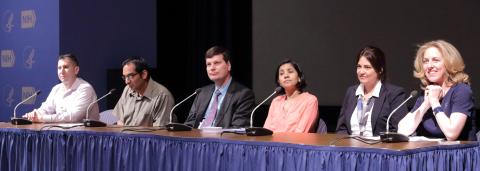An Inviting Ecosystem
America Is a Nation of Makers, Says HHS’s Fox

Photo: Ernie Branson
Susannah Fox, HHS chief technology officer, sees herself as a lookout sitting in a crow’s nest. Perched high atop a ship’s mast, the lookout’s job is to alert the crew down below to both hazards and opportunities on the horizon.
“The opportunity that I see in the current landscape is in manufacturing—the ability to prototype, test and share designs for medical and assistive devices at lower costs and on a faster timeline than we’ve ever imagined,” she said at the recent “Making Health: Inspiring Innovative Solutions for Research and Clinical Care” symposium in Masur Auditorium.
Fox presented the keynote address at the event, which also featured a panel discussion and five presentations from scientists who are using new technologies such as 3-D printing to improve health care.
From Dr. John Gibbon, who built the first heart-lung machine on his kitchen table, to Alaskan natives who can fix a plane or a boat with only duct tape and wire, the United States is a nation of makers, Fox said.
She called NIH a “shining beacon of creative confidence. This campus is full of people who look at a problem and say, ‘Let’s go, let’s solve this!’”

Photo: Ernie Branson
Fox encouraged the government to make it easier for the public to share their inventions with the government. For example, scientists could consult with experts who don’t technically have authority. In the health care setting, patients and caregivers are examples of those without authority.
“Our goal should be to create a movement or an ecosystem that is so inviting that lots of people want to contribute to it—even if they don’t work for us,” Fox said. “That’s the best and highest pursuit of science.”
In 2013, HHS created the Innovation, Design, Entrepreneurship and Action (IDEA) Lab to help meet this goal. The lab’s mission is to promote “the use of innovation across HHS to better enhance and protect the health and well-being of the public.” The lab emphasizes internal innovation, short-term tours of duty and sponsors conferences and prize competitions to spur innovation.
Fox concluded by urging the audience to tinker, experiment, share prototypes and “find ways to incentivize the maker movement spirit.”
After her keynote, four NIH scientists and one from Walter Reed National Military Medical Center gave presentations about their efforts to improve health care in the federal government.
The first presenter, George Dold of NIMH’s section on instrumentation, described how technologies such as 3-D printing allow researchers to become inventors. Scientists can explain what they want and then Dold can work with them to create devices and instruments.
Dr. Paige Derr, lead scientist of the tissue printing group at NCATS, described her work printing living human skin and retina tissue for use in the drug discovery process.

Photo: Ernie Branson
Dr. Maria Jaime of NIDDK’s Oliver Lab explained how she designed the Whole Animal Feeding Flat (WAFFL), a 96-well system for housing and feeding 96 fruit flies. Before she built the WAFFL, feeding flies with different treatments was a labor-intensive process.
“I found it very challenging to work with flies and drug treatments, so I started thinking, ‘How can I simplify my life?’” Jaime said. From there, she drew up a prototype, made it using a 3-D printer and then refined the design. The WAFFL allows her to feed the flies with different drug treatments faster than ever, using very small volumes of liquid food.
Dr. Stefan Jaeger, a research fellow at NLM’s Lister Hill Center for Biomedical Communications, spoke about his efforts to develop a smartphone app that detects malaria. The disease is a severe public health problem in tropical and subtropical parts of world. The app uses automatic image analysis software to accurately count how many malaria parasites there are in a sample of blood. It runs on a smartphone that attaches to a microscope.

Photo: Ernie Branson
Finally, Dr. Peter Liacouras, director of services at Walter Reed’s 3-D Medical Applications Center, said that, since 2003, the service has 3-D printed more than 7,000 anatomical models reconstructed from radiographic images for the Department of Defense and the Department of Veterans Affairs. In addition, the center has manufactured more than 300 custom cranial implants for Walter Reed. The anatomical models can help guide doctors before they perform surgery and give them a sense that they’ve been there before.
“We do whatever providers want us to do,” he said. “We don’t like to say no.”
After the presentations, Fox moderated a panel discussion. Asked what advice the presenters would give to those looking to take advantage of the maker movement, the panelists offered these tips: don’t discount ideas, acknowledge your limitations, don’t get frustrated when things don’t go according to plan and use every available resource—including colleagues.
The symposium was part of the White House’s National Week of Making.
